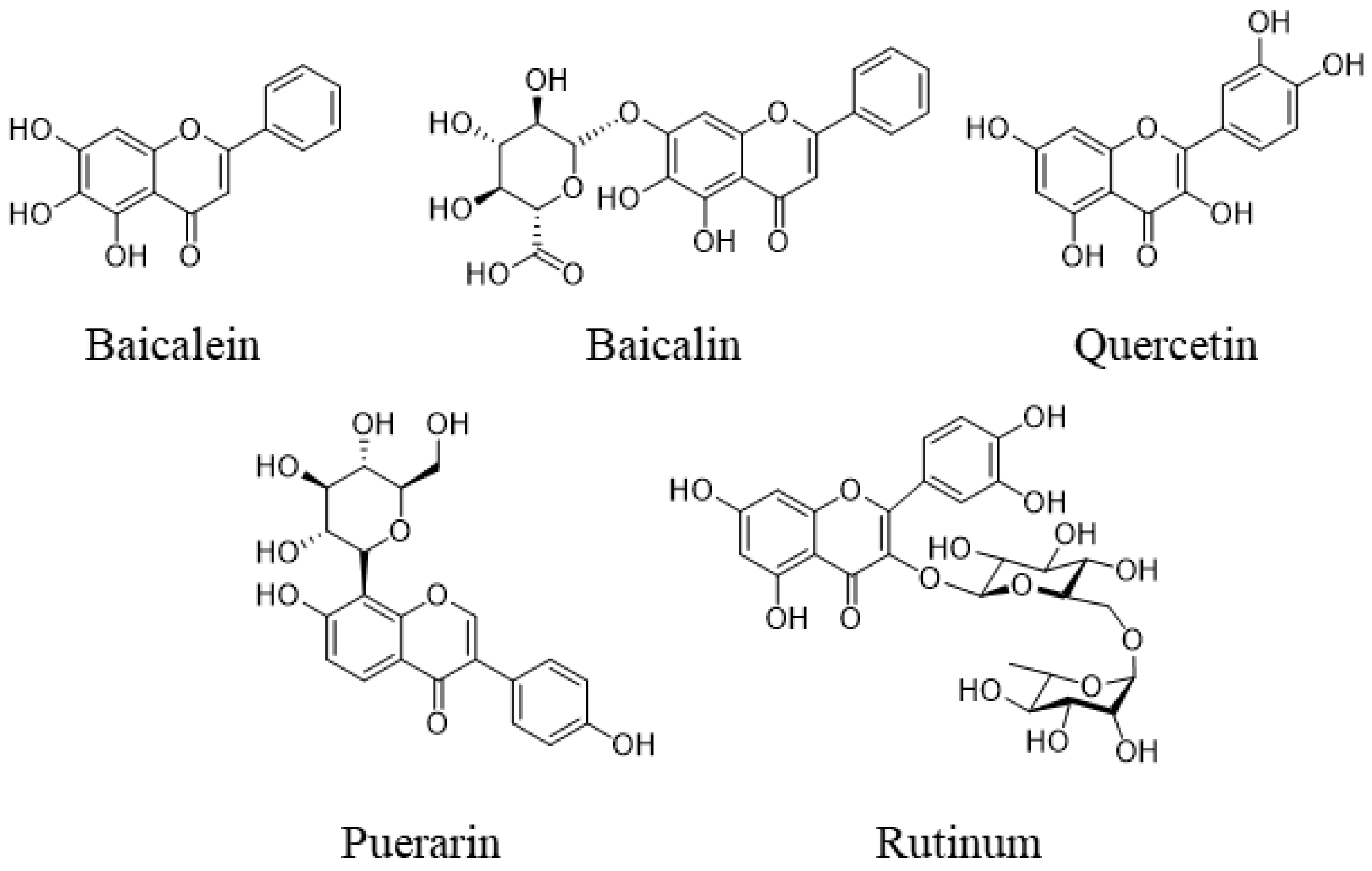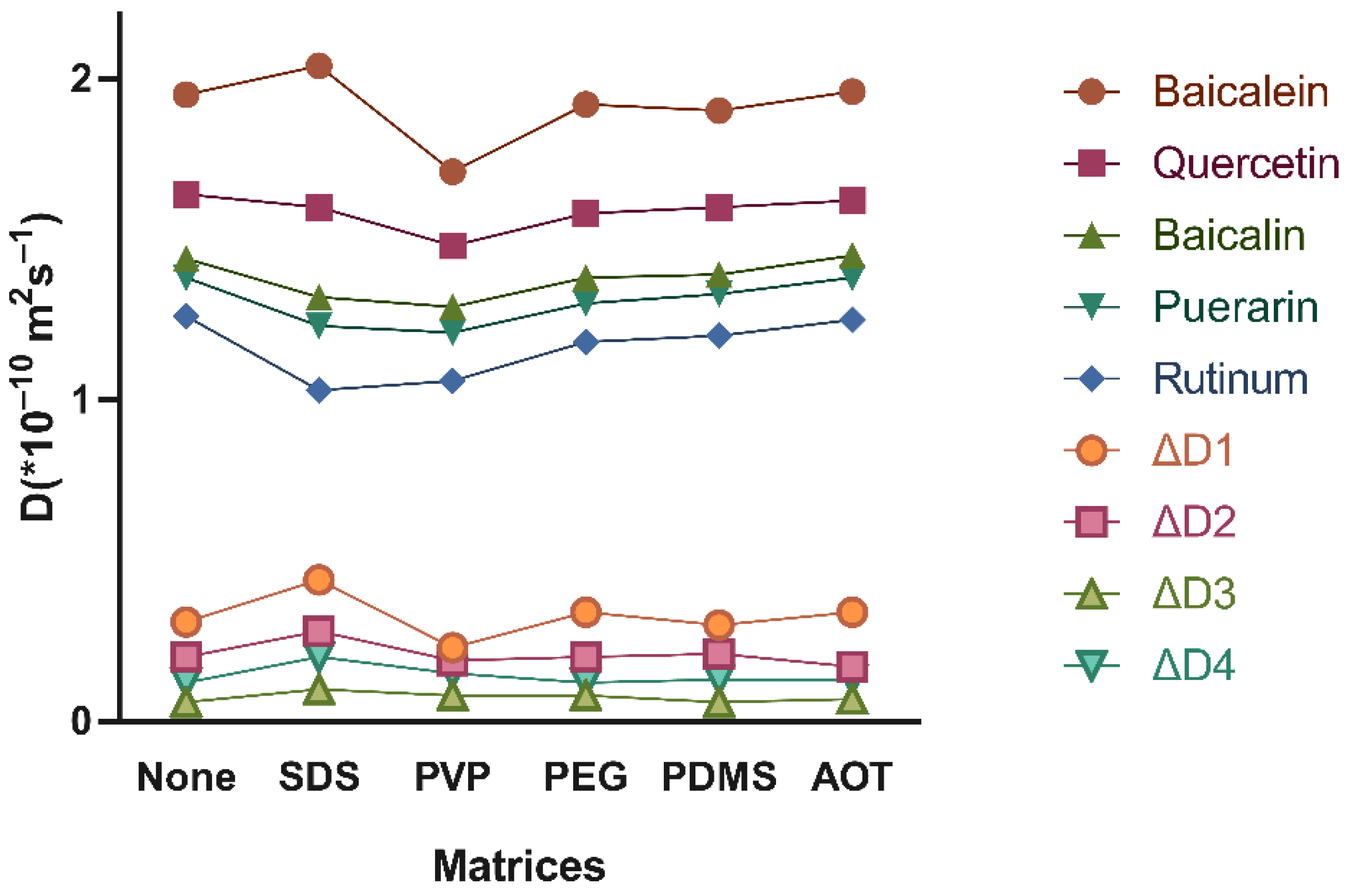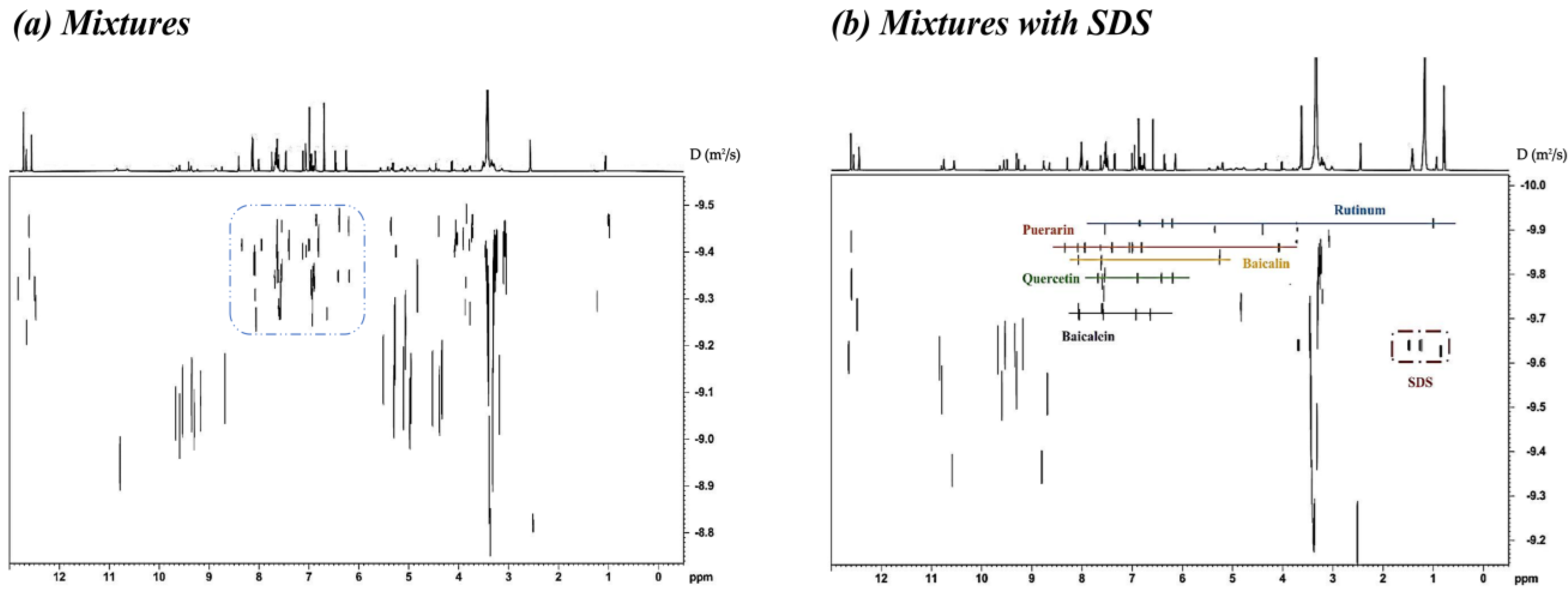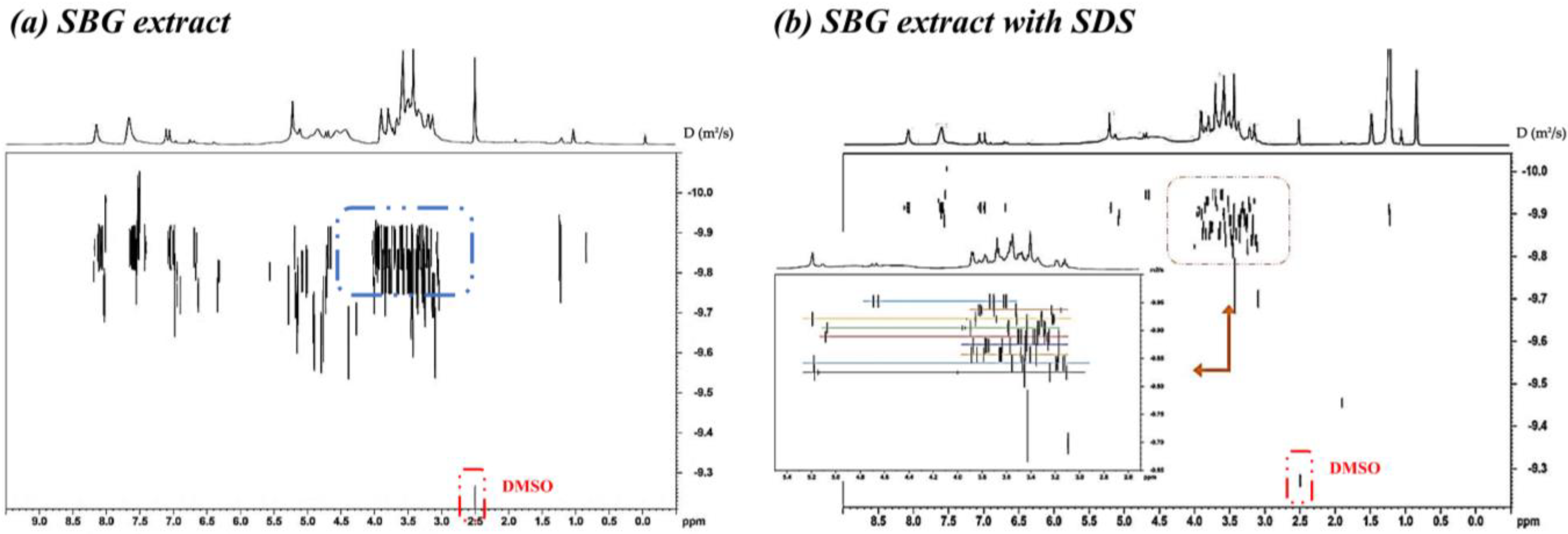1. Introduction
Scutellaria baicalensis Georgi (
S. baicalensis), also known as Camellia Root and Tujin Tea Root, is a perennial herb of the labiatae family with a long history of application. Modern research has proved that S. baicalensis has a wide range of pharmacological activities and broad-spectrum antibacterial effects [
1,
2]. For example, it is widely used in the clinical treatment of infections of the upper respiratory tract, gastrointestinal tractand urinary tract, because of its inhibitory effect on the growth of various Gram-positive/negative bacteria and spirochetes. A variety of active ingredients, such as flavonoids and their glycosides, namely flavonoids and flavonols, dihydroflavonoids and dihydroflavonols, flavanones, and chalcones, have been discovered in
S. baicalensis [
3]. Despite the existence of numerous flavonoids in natural plants, it is still a very challenging task to isolate and analyze flavonoids because of their complex structure and low content. The analysis of mixtures containing flavonoidsand the identification of isolated compounds, are usually accomplished by a combination of high-performance liquid chromatography (HPLC) and mass spectrometry [
4,
5]. However, the method is sometimes cumbersome, time-consuming, and the column, which is its main component, is rather expensive. Therefore, efficient identification of the flavonoids and clarification of the chemical composition of
S. baicalensis is necessary to further clarify its pharmacodynamic material basis and mechanism of action.
Nuclear magnetic resonance (NMR) is a non-destructive analysis technique that can simultaneously provide useful information about both structure and quantity of multiple chemical constituents [
6,
7,
8,
9], which makes it more advantageous compared with chromatography and mass spectrometry in the mixture analysis in the fields of food, chemistry, pharmacy, and biomedicine [
10,
11]. However, due to the structural similarity of flavonoids, complex and overlapping multiple signals will be generated, which makes it difficult to assign and interpret them clearly and accurately by NMR. Diffusion-ordered spectroscopy (DOSY) based on pulse field gradient (PFG) is featured by its high efficiency, low sample consumption, no damage to the sample and less influence from impurities, making it an important method to measure the self-diffusion coefficient (D) of different molecules [
12,
13]. Because of the high sensitivity of
1H NMR,
1H DOSY is still the commonly used two-dimensional DOSY in the analysis of alkaloids, flavonoids and terpenoids. However, because
1H NMR is limited by the narrow chemical shift range and the complexity of multi-structure J coupling [
14,
15], it is difficult to obtain a high-resolution DOSY spectrum and accurately analyze the mixture components in the spectrum with serious overlapping peaks [
16]. To solve the problems, the researchers have extended the DOSY experiment to other nuclei, such as
7Li,
19F, and
13C [
17,
18,
19]. The wider chemical shifts and little or no spin coupling of such nuclei generally reduces the overlap problems compared to 1H nuclei. However, the low natural abundance of 13C nuclei greatly reduced the sensitivity and the use of nuclei such as
7Li,
19F is also limited to the analysis of components containing the specific nucleus [
20,
21,
22].
Alternatively, the chemical environment of the analytes can be altered by adding a matrix to enhance diffusion separation and DOSY analysis, which is known as matrix-assisted DOSY [
23]. The principle is a matrix with a relatively large diffusion coefficient added into the mixture interactes with the components and affected their mobility, which then further increases the diffusion coefficient differences between similar components, so as to achieve the purpose of distinguishing each component [
24]. At present, matrix-assisted DOSY technology has been rarely used to analyze the active ingredients in natural products.
To sum up, we established a flavonoid mixture model, which is composed of five different types of flavonoid compounds (as shown in
Figure 1), to prove the application of matrix-assisted DOSY technology in separating mixture of flavonoids. Considering the structural similarity of the flavonoids, different species of matrix were screened for their ability to adjust the diffusion coefficients of various analytes and resolve the signal overlap on the spectrum. Subsequently, the NMR experimental parameters were optimized. The factors affecting the experimental results, including the concentration of VSP, the polarity of the solvent, and the content of the analyte, were also investigated. After the optimal experimental conditions were determined, the technology was applied to the analysis of total flavonoid extract obtained from
S. baicalensis. Through the research and development of detection methods, the application scope of matrix-assisted DOSY in the field of complex system analysis has been extended, and a reliable and effective method for separation and identification of mixtures is proposed.
2. Materials and Methods
2.1. Instrumentation
The following instrumentation was utilized: a BRUKER AVANCE 600 MHz NMR spectrometer consisting of a BBO 600S3 BBF SP multi-function normal temperature probe (BRUKER, Fällanden, Switzerland), a MSA36S electronic analytical balance (Satorius, AG, Goettingen, Germany), and an SB-4200 DTD ultrasonic cleaning machine (Ningbo Xinzhi Biotechnology Co., Ltd., Ningbo, China), a rotary centrifugal concentrator (Thermo Fisher Scientific Co., Ltd., Shanghai, China), a Turbovap LV nitrogen blower (Caliper Life Sciences, Boston, MA, USA), a Vortex-Genie shaking (Scientific Industries, New York, NY, USA), and a medicinal pulverizer (Xiaoxiong Electric Co., Ltd., Guangdong, China).
2.2. Chemicals and Reagents
The following reagents and materials were obtained: dimethyl sulfoxide–d6 (DMSO–d6, 99.9%) and deuterated methanol (MeOD, 99.8%) (Cambridge Isotope Laboratories, Inc., Andover, MA, USA), methanol, formic acid, and acetonitrile reagents (chromatographically pure, Tedia, Shanghai, China), baicalein (BAIE, 98%) and baicalin (BAI, 95%) (Shanghai Macklin Biochemical Co., Ltd., Shanghai, China), quercetin (QUE, 97%) and rutinumum (RUT, 95%) (Shanghai Aladdin Bio-Chem Technology Co., Ltd., Shanghai, China), puerarin (PUE, 95%, Beijing strongerscience Technology Co., Ltd., Beijing, China), sodium dodecyl sulfate (SDS, Beijing Solarbio Science & Technology Co., Ltd., Beijing, China), polyvinylpyrrolidone (PVP, MW: 10,000), polyethyleneglycol (Polyethyleneglycol), PEG, MW: 4000), polydimethylsiloxane (PDMS) and sodium bis(2-ethylhexyl) sulfosuccinate (AOT) (Shanghai Macklin Biochemical Co., Ltd., Shanghai, China), S. baicalensis (Shandong Jianlian Traditional Chinese Medicine Store, Jianlian, China).
2.3. Experimental Methods
2.3.1. Investigate the Separation Effect of Different Matrix on the Flavonoid Mixture
BAIE, BAI, QUE, PUE and RUT (3 mg each) were dissolved in 600 μL DMSO–d6, and mixed evenly. The samples were stored in a 4 °C refrigerator for subsequent us. Five aliquots of the model mixture solution were prepared in parallel, and mixed with SDS, PVP, PEG, PDMS and AOT, respectively. After equilibration at 303 K for 30 min in the NMR spectrometer, the DOSY spectrum of each sample was collected.
2.3.2. Investigation of Influencing Factors
To investigate the effect of SDS concentration, the flavonoids mixture solution was supplemented with 3 mg, 6 mg, 9 mg, 12 mg and 15 mg of SDS, respectively, and then their DOSY spectrum was collected. To investigate the effect of solvent polarity, the five flavonoids (3 mg each) were dissolved in 600 μL MeOD and mixed evenly for DOSY measurement.
2.3.3. Optimization of Experimental Conditions for DOSY NMR
In routine NMR experiments, the default value of NS is 8, TD is 16, and DS is 4. Therefore, in this experiment, in order to examine the influence of sampling parameters on the experiment, DS was set as 0, 4, 8 and 16; NS is set as 8, 16, 32 and 64; and TD is set as 16, 32, 64 and 128, respectively. Three DOSY experiments were collected at each value, and the diffusion coefficient for each analyte was averaged from three results.
2.3.4. Applying the MA DOSY Technique to Real Samples
The S. baicalensis medicinal materials (200 g) were crushed into powder and soaked in 1000 mL 60% ethanol for 24 h. The medicinal materials were then extracted by ultrasonic method for 2 h. The crude extract was concentrated by vacuum rotary evaporator, yielding the total flavonoids extract of S. baicalensis. The total flavonoids (25 mg) were dissolved in 600 μL DMSO–d6 supplemented with 10 mg SDS and the DOSY spectra were collected later.
2.4. NMR Experiment Conditions and Data Processing
Routine DOSY NMR experiments were carried out using the BRUKER-AVANCE 600 MHz NMR instrument equipped with a BBO 600S3 BBF SP probe. The diffusion measurements were recorded using an LEDBPGP2S pulse sequence, ramping the gradient from 2% to95% of maximum strength in 30 steps. All 1H-NMR spectra were obtained at a spectral width of 12,019.230 Hz, and the number of acquired complex data points was 4096. Diffusion experiments were advanced using a 0.6 ms spoil gradient duration, a 1 ms relaxation delay, and a 5 ms eddy current recovery delay. The experimental temperature was set at 298 K, except for specific testing requirements. The diffusion times and gradient pulse duration were optimized in subsequent experiments according to practical needs. The data of the mixtures were apodized by a sine function and zero-filled up to 65,536 complex data points. With regard to the fourier transformation, phase adjustment, and baseline correction, the diffusion dimension was processed by Bruker Topspin 3.6.2 spectrometer operating software. Finally, two-dimensional DOSY spectra were further analyzed by BRUKER Dynamics Center 2.6.2 and MestReNova 14.2.0 software.
3. Results
3.1. Evaluation of Flavonoid Mixtures Separation by Different Matrix Using DOSY
In the first part of this experiment, a series of matrix, including surfactants (SDS, AOT) and polymers (PEG, PVP, PDMS), were investigated for their separation performance of the selected mixture model. Good separation performance can justify it worthy of our further study. As we can see from
Figure 2, most of the matrix improved the separation of the analyte signals in the mixture to varying degrees. But the surfactant SDS provided the best separation, and by using SDS, the separation and analysis of these five flavonoids achieved ΔD1 = 21.6%, ΔD2 = 17.5%, ΔD3 = 7.6% and ΔD4 = 16.3%, respectively (ΔD% refers to the percent difference in diffusion coefficient between different analytes, and ΔD
1 = ΔD
(BAIE-QUE), ΔD
2 = ΔD
(QUE-BAI), ΔD
3 = ΔD
(BAI-PUE), ΔD
4 = ΔD
(PUE-RUT)).
As shown in the DOSY spectrum (
Figure 3a), the five flavonoids in the mixture model (as shown in
Figure 1) were not separated in the diffusion dimension. Since the molecular mass difference between PUE and BAI is very small, the difference in the diffusion coefficient between the two is thus very small according to the Stokes-Einstein equation, which makes the analysis signal not completely separated. On the contrary, the five flavonoids were satisfactorily resolved in the presence of SDS (
Figure 3b). The reason might be that the different interactions between the components in the mixture and the SDS micelles make them exhibit different diffusion coefficients, which allowed the analyte signals to be well resolved in the diffusion dimension, allowing us to assign the signals to the five flavonoids.
3.2. Evaluation of Different Influencing Factors
3.2.1. The Effect of SDS Concentration on the Separation Effect
As shown in
Figure 4, the ΔD of each component in the model mixture gradually increased from 0 mg to 9 mg. When the amount of SDS in the solution increases, more SDS interacted with the analytes, resulting in significant changes in their diffusion characteristics. We can see from
Figure 1 that the main difference between the five flavonoids lies in the different functional groups. Because of the different interactions between the functional groups and SDS molecules, the analytes exhited different diffusion coefficients. RUT contains 9 hydroxyl groups and has the strongest interaction with SDS, so the diffusion coefficient is the smallest. Followed by PUE, BAI, QUE, the intensity of action decreased in turn, and the diffusion coefficient correspondingly increased gradually. Finally, BAIE has only 3 hydroxyl groups, and the interaction between the analyte and SDS is the weakest, so the diffusion rate is the fastest and the largest diffusion coefficient is obtained.
However, when the interaction between SDS and the analyte reaches saturation, addition of more SDS will significantly enhance the intermolecular aggregation, which directly leads to a significant increase in the viscosity of the solution. According to the Stokes-Einstein equation, a high solution viscosity will slow down the diffusion rate of the components, further reducing the D values.
3.2.2. Influence of Solvent Polarity on Separation Effect
Here, we investigated the effect of solvents of different polarities on the separation of the model mixture, and the results are shown in
Figure 5.
It can be seen from
Figure 5 that the separation effect of the model mixture in DMSO–
d6 is much better than that in MeOD. Considering the properties of the analyte and the solvent, the difference in diffusion coefficient between the analytes might be attributed to to hydrogen bonding between the analyte and the solvent. The stronger the hydrogen bond formed between the analyte molecule and the solvent, the stronger the steric hindrance effect of the analyte in solution is, therefore, resulting in less diffusion. Both DMSO–
d6 and MeOD can form hydrogen bonds with the mixture components in solution. However, the hydroxyl groups in the liquid alcohol molecules can also spontaneously associate through hydrogen bonds, which increases the steric hindrance and affects the diffusion of analyte molecules, thereby reducing the diffusion coefficient. Therefore, we can see from
Figure 5 that the separation effect of the mixture in DMSO–
d6 is better than that in MeOD.
3.3. Optimization of DOSY NMR Experimental Conditions
DOSY technology enables virtual separation of components in mixtures and is a powerful tool for separation and analysis of mixtures. However, the experimental operation steps involved in the conventional DOSY experiment are complicated and tedious, so some experimental parameters need to be optimized to improve the separation effect.
We optimized the experimental parameter DS to observe its influence on the experiment. As can be seen from
Figure 6a, when DS increases from 0 to 8, the separation effect (ΔD) has a rising process, which indicates the presence of DS is beneficial for DOSY experiments. However, when DS is larger than 8, the separation effect curve gradually becomes stable. When DS increases to a certain value, the instrument has entered a stable state, and the separation effect will not be improved.
As can be seen from
Figure 6b, when NS is 8, the resolution between the analytes is low, and it is because that low NS affects the signal-to-noise ratio of the experiment. With the increase of NS, the separation effect increases slowly, but in the case of sufficient analyte sample concentration, a high NS larger than 32 will weaken the separation between components.
In order to examine the influence of TD on the separation effect, we set it to 4 data points of 16, 32, 64 and 128, respectively. There is an obvious increase between 16 and 32, indicating that the increase of TD has a positive effect on optimizing the experimental results. But at the same time, too high TD will make the test time of the spectrum increase exponentially, which should also be considered.
Table 1 summarizes all experimental parameters and their variations, and the optimal value for this parameter is shown in bold in the table.
3.4. Application of SDS-Assisted DOSY Technique to the Separation of Total Flavonoid Extract Mixture of S. baicalensis
Through the above experiments, it is determined that SDS is used as the experimental matrix, and the NMR conditions and influencing factors are also optimized. Referring to the above experimental results, it can be considered that the experimental method can successfully perform virtual separation of flavonoid mixtures, and has a good separation effect. In addition, the nuclear magnetic signal can be identified to distinguish and match the corresponding compounds. Therefore, we introduced this technology into practical analysis, and selected the total flavonoid extract of S. baicalensis as the analysis object, so as to investigate the practical value of this method in practical application.
The trational DOSY spectrum of the total flavonoids extract of
S. baicalensis is shown in
Figure 7a. It can be clearly seen that the components are mixed in the diffusion dimension. Therefore, an additional matrix is needed. The DOSY map in the presence of SDS is shown in
Figure 7b. By zooming in on the map, it can be clearly shown that after adding SDS, the components in the mixture have achieved a better degree of separation. In addition, the signals at the diffusion dimension were separated according to the different diffusion coefficients, and the
1H NMR spectra of nine compounds were roughly extracted. In the previous work, our laboratory established an experimental
1H spectrum database of flavonoids in
S. baicalensis, which included a total of 133 flavonoids isolated from
S. baicalensis. Then we used the database to search the
1H NMR extracted from the DOSY spectrum, and identified 9 corresponding compounds as shown in
Table 2.
Subsequently, we analyzed the
S. baicalensis extract by positive ion scanning. The mass spectrometry data was analyzed using Xcalibur software. Comparison between the search results and mass spectrometry results further demonstrated the presence of the components in the mixed system. By comparison, the best matching compounds retrieved by MestReNova are similar to the results of MS analysis (as shown in
Table S1 and Figure S1 in supporting information). Therefore, it can be considered that the compounds listed in
Table 2 are the components separated from the total flavonoid extract of
S. baicalensis.
In this experiment, the feasibility of the method was verified by applying the MA DOSY technology to the actual sample of S. baicalensis. In addition, combined with other software and methods, the components in the S. baicalensis extract could be qualitatively analyzed, which provides a scientific basis for subsequent research.














